全部倒装和部分倒装知识点
英语倒装句:部分倒装与全部倒装
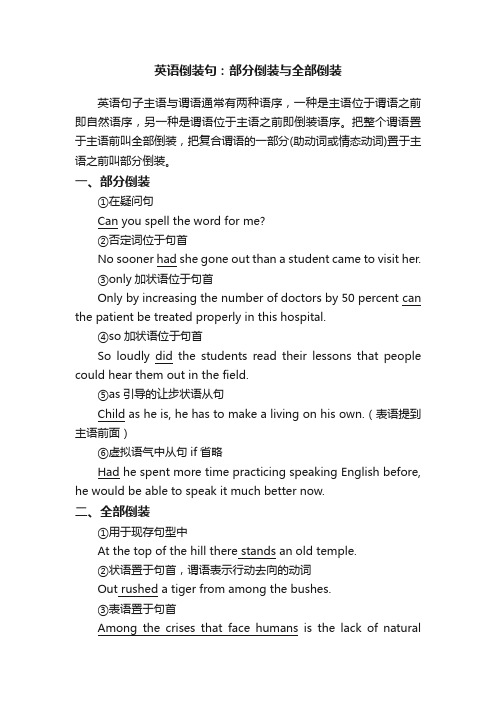
英语倒装句:部分倒装与全部倒装英语句子主语与谓语通常有两种语序,一种是主语位于谓语之前即自然语序,另一种是谓语位于主语之前即倒装语序。
把整个谓语置于主语前叫全部倒装,把复合谓语的一部分(助动词或情态动词)置于主语之前叫部分倒装。
一、部分倒装①在疑问句Can you spell the word for me?②否定词位于句首No sooner had she gone out than a student came to visit her.③only加状语位于句首Only by increasing the number of doctors by 50 percent can the patient be treated properly in this hospital.④so加状语位于句首So loudly did the students read their lessons that people could hear them out in the field.⑤as引导的让步状语从句Child as he is, he has to make a living on his own.(表语提到主语前面)⑥虚拟语气中从句if省略Had he spent more time practicing speaking English before, he would be able to speak it much better now.二、全部倒装①用于现存句型中At the top of the hill there stands an old temple.②状语置于句首,谓语表示行动去向的动词Out rushed a tiger from among the bushes.③表语置于句首Among the crises that face humans is the lack of naturalresources.。
【英语知识点】部分倒装与完全倒装的区别

【英语知识点】部分倒装与完全倒装的区别完全倒装与部分倒装是英语中常见的语法现象,但是不少的同学却对于两种倒装的形式和意义无法准确地理解和把握。
本文整理了二者的区别,希望对你有所帮助。
倒装句是将正常的陈述语序加以变化,主要作用是强调被提前的部分,分为两种:一、全部倒装:谓语动词提前至主语之前;二、部分倒装:助动词或情态动词提至主语之前,谓语动词位置不变。
一、全部倒装示例如下:1、Here,There,Now,Then等副词放在句首时,句子要全部倒装,谓语动词常用e,go,be,lie,run等。
例如:There es the bus!Now es your turn.2、表示方位的副词或介词短语置于句首时,句子要全部倒装,句中的谓语动词是e,go等表示运动的动词。
The door opened and in came the headmaster.二、部分倒装示例如下:1、否定副词如no,not,never,seldom,little,hardly,以及含有no,not的短语放在句首时,句子要部分倒装。
Never in my life have I heard such a thing. Little did we expect that he could e.注意:如上述句子中的否定副词不置于句首时,句子结构不倒装。
2、以否定词开头的关联结构No sooner…than…,Hardly/scarcely…when…,Not only…but also,Not until…有承上启下作用,表示同意和赞同:例:A: I couldn't do anything for her.(我帮不了她。
)B: Nor you could, but you might have got somebody to help her.(你是不能帮她,但你本可以找人帮她的。
)2) 在进行比较的句子里,如果主语不是代词时,可以倒装:例:America consumes more energy than did our country.(美国消耗的能源比我们国家多。
(完整版)倒装句的讲解
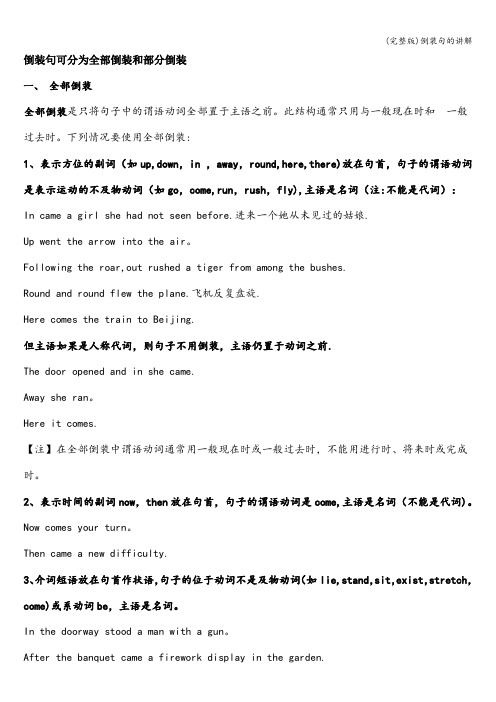
倒装句可分为全部倒装和部分倒装一、全部倒装全部倒装是只将句子中的谓语动词全部置于主语之前。
此结构通常只用与一般现在时和一般过去时。
下列情况要使用全部倒装:1、表示方位的副词(如up,down,in ,away,round,here,there)放在句首,句子的谓语动词是表示运动的不及物动词(如go,come,run,rush,fly),主语是名词(注:不能是代词):In came a girl she had not seen before.进来一个她从未见过的姑娘.Up went the arrow into the air。
Following the roar,out rushed a tiger from among the bushes.Round and round flew the plane.飞机反复盘旋.Here comes the train to Beijing.但主语如果是人称代词,则句子不用倒装,主语仍置于动词之前.The door opened and in she came.Away she ran。
Here it comes.【注】在全部倒装中谓语动词通常用一般现在时或一般过去时,不能用进行时、将来时或完成时。
2、表示时间的副词now,then放在句首,句子的谓语动词是come,主语是名词(不能是代词)。
Now comes your turn。
Then came a new difficulty.3、介词短语放在句首作状语,句子的位于动词不是及物动词(如lie,stand,sit,exist,stretch,come)或系动词be,主语是名词。
In the doorway stood a man with a gun。
After the banquet came a firework display in the garden.On the moon, as is known to all,exists no living thing。
完全倒装与部分倒装
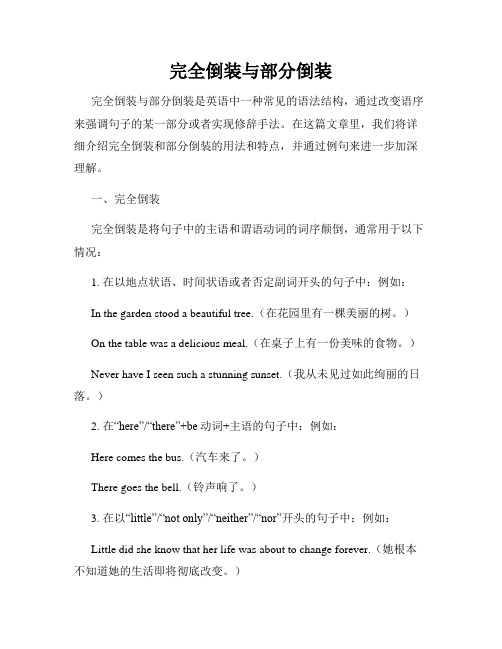
完全倒装与部分倒装完全倒装与部分倒装是英语中一种常见的语法结构,通过改变语序来强调句子的某一部分或者实现修辞手法。
在这篇文章里,我们将详细介绍完全倒装和部分倒装的用法和特点,并通过例句来进一步加深理解。
一、完全倒装完全倒装是将句子中的主语和谓语动词的词序颠倒,通常用于以下情况:1. 在以地点状语、时间状语或者否定副词开头的句子中:例如:In the garden stood a beautiful tree.(在花园里有一棵美丽的树。
)On the table was a delicious meal.(在桌子上有一份美味的食物。
)Never have I seen such a stunning sunset.(我从未见过如此绚丽的日落。
)2. 在“here”/“there”+be动词+主语的句子中:例如:Here comes the bus.(汽车来了。
)There goes the bell.(铃声响了。
)3. 在以“little”/“not only”/“neither”/“nor”开头的句子中:例如:Little did she know that her life was about to change forever.(她根本不知道她的生活即将彻底改变。
)Not only is he intelligent, but he is also kind-hearted.(他不仅聪明,而且心地善良。
)Neither did I agree with his decision, nor did I understand his reasoning.(我既不同意他的决定,也不理解他的理由。
)二、部分倒装部分倒装是将助动词、情态动词或者“be”动词与主语的词序颠倒,同样用于强调句子的某一部分或者实现修辞手法。
常见的部分倒装情况包括:1. 在以否定词开头的句子中:例如:Never have I been so inspired.(我从未如此受到鼓舞。
倒装句子知识点总结
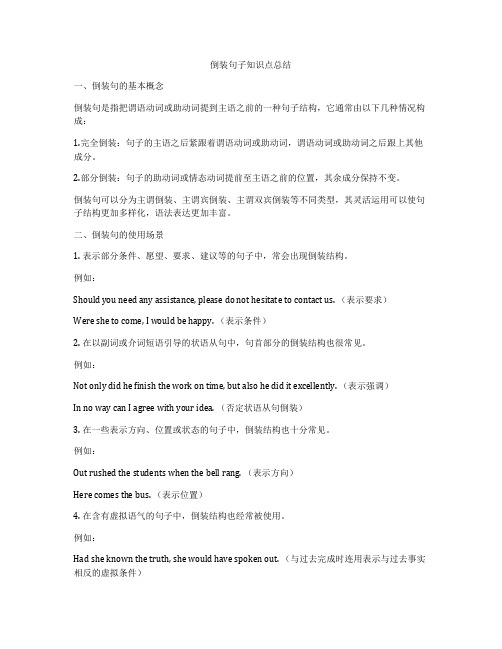
倒装句子知识点总结一、倒装句的基本概念倒装句是指把谓语动词或助动词提到主语之前的一种句子结构,它通常由以下几种情况构成:1.完全倒装:句子的主语之后紧跟着谓语动词或助动词,谓语动词或助动词之后跟上其他成分。
2.部分倒装:句子的助动词或情态动词提前至主语之前的位置,其余成分保持不变。
倒装句可以分为主谓倒装、主谓宾倒装、主谓双宾倒装等不同类型,其灵活运用可以使句子结构更加多样化,语法表达更加丰富。
二、倒装句的使用场景1. 表示部分条件、愿望、要求、建议等的句子中,常会出现倒装结构。
例如:Should you need any assistance, please do not hesitate to contact us. (表示要求)Were she to come, I would be happy. (表示条件)2. 在以副词或介词短语引导的状语从句中,句首部分的倒装结构也很常见。
例如:Not only did he finish the work on time, but also he did it excellently. (表示强调)In no way can I agree with your idea. (否定状语从句倒装)3. 在一些表示方向、位置或状态的句子中,倒装结构也十分常见。
例如:Out rushed the students when the bell rang. (表示方向)Here comes the bus. (表示位置)4. 在含有虚拟语气的句子中,倒装结构也经常被使用。
例如:Had she known the truth, she would have spoken out. (与过去完成时连用表示与过去事实相反的虚拟条件)Should I be the one chosen, I promise to work hard. (与虚拟条件连用)三、倒装句的基本结构及使用方法1. 主谓倒装在一些特殊情况下,主语和谓语的位置会倒置。
倒装用法总结
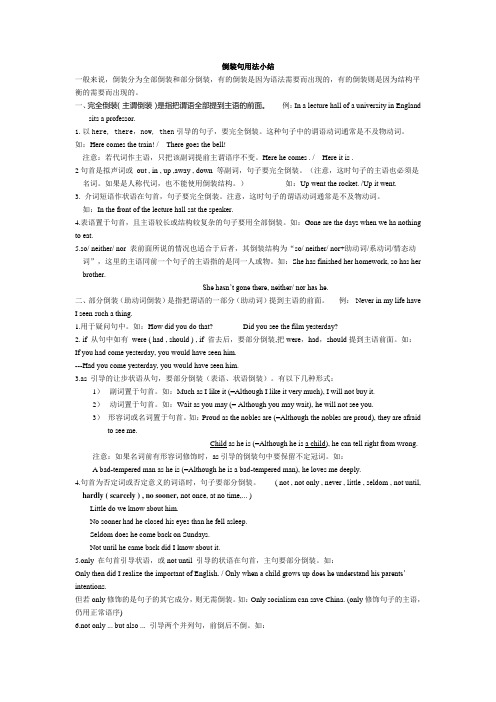
倒装句用法小结一般来说,倒装分为全部倒装和部分倒装,有的倒装是因为语法需要而出现的,有的倒装则是因为结构平衡的需要而出现的。
一、完全倒装(主谓倒装)是指把谓语全部提到主语的前面。
例:In a lecture hall of a university in Englandsits a professor.1.以here, there,now, then引导的句子,要完全倒装。
这种句子中的谓语动词通常是不及物动词。
如:Here comes the train! / There goes the bell!注意:若代词作主语,只把该副词提前主谓语序不变。
Here he comes . / Here it is .2句首是拟声词或out , in , up ,away , down 等副词,句子要完全倒装。
(注意,这时句子的主语也必须是名词。
如果是人称代词,也不能使用倒装结构。
)如:Up went the rocket. /Up it went.3. 介词短语作状语在句首,句子要完全倒装。
注意,这时句子的谓语动词通常是不及物动词。
如:In the front of the lecture hall sat the speaker.4.表语置于句首,且主语较长或结构较复杂的句子要用全部倒装。
如:Gone are the days when we ha nothing to eat.5.so/ neither/ nor 表前面所说的情况也适合于后者,其倒装结构为“so/ neither/ nor+助动词/系动词/情态动词”,这里的主语同前一个句子的主语指的是同一人或物。
如:She has finished her homework, so has her brother.She hasn’t gone there, neither/ nor has he.二、部分倒装(助动词倒装)是指把谓语的一部分(助动词)提到主语的前面。
倒装(全部倒装和部分倒装)
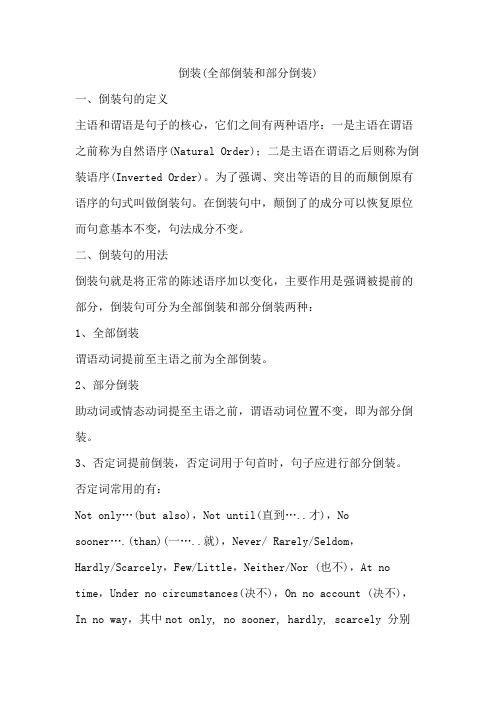
倒装(全部倒装和部分倒装)一、倒装句的定义主语和谓语是句子的核心,它们之间有两种语序:一是主语在谓语之前称为自然语序(Natural Order);二是主语在谓语之后则称为倒装语序(Inverted Order)。
为了强调、突出等语的目的而颠倒原有语序的句式叫做倒装句。
在倒装句中,颠倒了的成分可以恢复原位而句意基本不变,句法成分不变。
二、倒装句的用法倒装句就是将正常的陈述语序加以变化,主要作用是强调被提前的部分,倒装句可分为全部倒装和部分倒装两种:1、全部倒装谓语动词提前至主语之前为全部倒装。
2、部分倒装助动词或情态动词提至主语之前,谓语动词位置不变,即为部分倒装。
3、否定词提前倒装,否定词用于句首时,句子应进行部分倒装。
否定词常用的有:Not only…(but also),Not until(直到…..才),No sooner….(than)(一…..就),Never/ Rarely/Seldom,Hardly/Scarcely,Few/Little,Neither/Nor (也不),At no time,Under no circumstances(决不),On no account (决不),In no way,其中not only, no sooner, hardly, scarcely 分别和but (also), than, when搭配使用,需注意:后一组词之后的部分不进行倒装,只有否定词之后的部分倒装。
4、副词提前倒装副词提至句首引起倒装,可分以下几种情况:only + 副词(when, before, if, after等)或only+介词状语(由in, under, by, on, after等引导)提前,必须部分倒装。
例句:Only then did he realize how stupid he had been. often, such, so等副词提前,部分倒装。
全部倒装与部分倒装
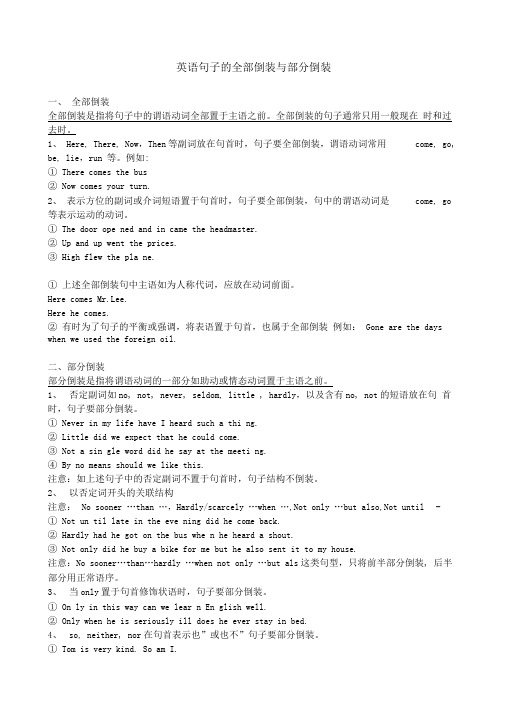
英语句子的全部倒装与部分倒装一、全部倒装全部倒装是指将句子中的谓语动词全部置于主语之前。
全部倒装的句子通常只用一般现在时和过去时。
1、Here, There, Now,Then等副词放在句首时,句子要全部倒装,谓语动词常用come, go, be, lie,run 等。
例如:①There comes the bus②Now comes your turn.2、表示方位的副词或介词短语置于句首时,句子要全部倒装,句中的谓语动词是come, go 等表示运动的动词。
①The door ope ned and in came the headmaster.②Up and up went the prices.③High flew the pla ne.①上述全部倒装句中主语如为人称代词,应放在动词前面。
Here comes Mr.Lee.Here he comes.②有时为了句子的平衡或强调,将表语置于句首,也属于全部倒装例如:Gone are the days when we used the foreign oil.二、部分倒装部分倒装是指将谓语动词的一部分如助动或情态动词置于主语之前。
1、否定副词如no, not, never, seldom, little , hardly,以及含有no, not的短语放在句首时,句子要部分倒装。
①Never in my life have I heard such a thi ng.②Little did we expect that he could come.③Not a sin gle word did he say at the meeti ng.④By no means should we like this.注意:如上述句子中的否定副词不置于句首时,句子结构不倒装。
2、以否定词开头的关联结构注意:No sooner …than …,Hardly/scarcely …when …,Not only …but also,Not until -①Not un til late in the eve ning did he come back.②Hardly had he got on the bus whe n he heard a shout.③Not only did he buy a bike for me but he also sent it to my house.注意:No sooner…than…hardly …when not only …but als这类句型,只将前半部分倒装, 后半部分用正常语序。
倒装句知识点
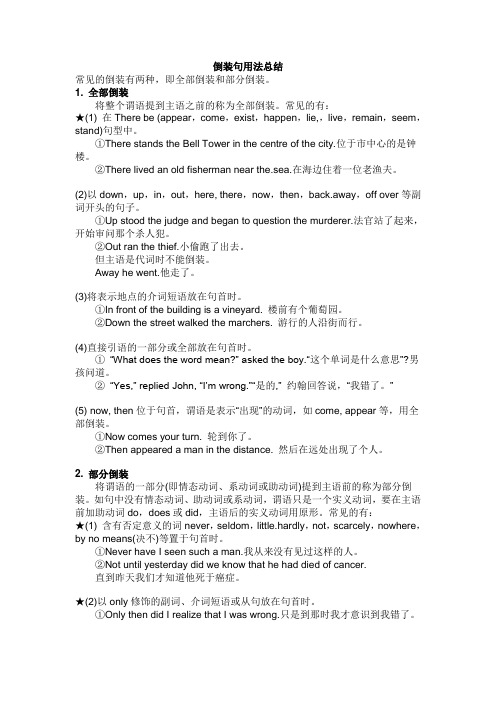
倒装句用法总结常见的倒装有两种,即全部倒装和部分倒装。
1. 全部倒装将整个谓语提到主语之前的称为全部倒装。
常见的有:★(1) 在There be (appear,come,exist,happen,lie,,live,remain,seem,stand)句型中。
①There stands the Bell Tower in the centre of the city.位于市中心的是钟楼。
②There lived an old fisherman near the.sea.在海边住着一位老渔夫。
(2)以down,up,in,out,here, there,now,then,back.away,off over等副词开头的句子。
①Up stood the judge and began to question the murderer.法官站了起来,开始审问那个杀人犯。
②Out ran the thief.小偷跑了出去。
但主语是代词时不能倒装。
Away he went.他走了。
(3)将表示地点的介词短语放在句首时。
①In front of the building is a vineyard. 楼前有个葡萄园。
②Down the street walked the marchers. 游行的人沿街而行。
(4)直接引语的一部分或全部放在句首时。
①“What does the word mean?” asked the boy.“这个单词是什么意思”?男孩问道。
②“Yes,” replied John, “I’m wrong.”“是的,” 约翰回答说,“我错了。
”(5) now, then位于句首,谓语是表示“出现”的动词,如come, appear等,用全部倒装。
①Now comes your turn. 轮到你了。
②Then appeared a man in the distance. 然后在远处出现了个人。
倒装知识点详解及习题,带详解
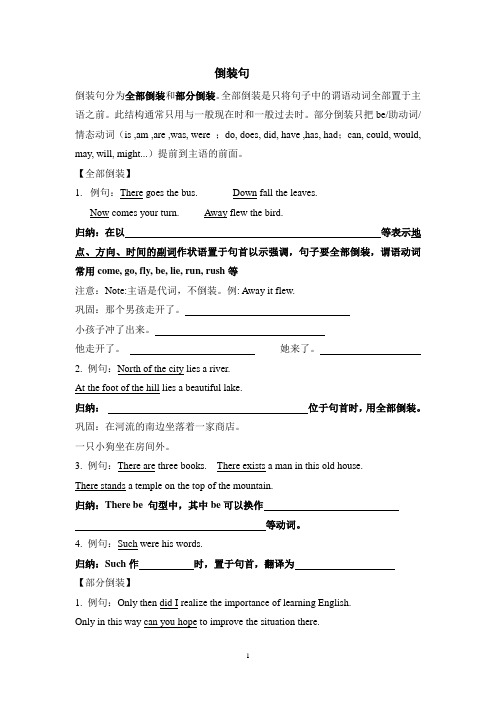
倒装句倒装句分为全部倒装和部分倒装。
全部倒装是只将句子中的谓语动词全部置于主语之前。
此结构通常只用与一般现在时和一般过去时。
部分倒装只把be/助动词/情态动词(is ,am ,are ,was, were ;do, does, did, have ,has, had;can, could, would, may, will, might...)提前到主语的前面。
【全部倒装】1.例句:There goes the bus. Down fall the leaves.Now comes your turn. Away flew the bird.归纳:在以等表示地点、方向、时间的副词作状语置于句首以示强调,句子要全部倒装,谓语动词常用come, go, fly, be, lie, run, rush等注意:Note:主语是代词,不倒装。
例: Away it flew.巩固:那个男孩走开了。
小孩子冲了出来。
他走开了。
她来了。
2. 例句:North of the city lies a river.At the foot of the hill lies a beautiful lake.归纳:位于句首时,用全部倒装。
巩固:在河流的南边坐落着一家商店。
一只小狗坐在房间外。
3. 例句:There are three books. There exists a man in this old house.There stands a temple on the top of the mountain.归纳:There be 句型中,其中be可以换作等动词。
4. 例句:Such were his words.归纳:Such作时,置于句首,翻译为【部分倒装】1. 例句:Only then did I realize the importance of learning English.Only in this way can you hope to improve the situation there.Only after he came back was I able to see him.归纳:only所修饰的放在句首时, 要进行部分倒装,主倒从不倒注:only修饰主语,不倒装,如:Only socialism can save China.Only he can do this job.2. 例句:Never have I seen a better film. Seldom does he go to the park.In no case did he give in to the enemy.归纳:位于句首时,用部分倒装。
全部倒装和部分倒装知识点

全部倒装和局部倒装英语最根本词序“主语局部+谓语局部〞通常十分固定。
如果把谓语动词放在主语前面,这就叫做倒装。
将谓语动词完全移至主语之前,称为完全倒装;如果只是把助动词或情态动词放在主语之前,称为局部倒装。
一、全部倒装1.以here, there,now,then开头的句子,谓语动词要放在句子主语之前。
这种句子谓语动词常是不及物动Here comes the train!There goes the bell!注意:如果句子的主语是人称代词,那么不能使用倒装构造。
Here it comes!There it goes!2.有些动词短语以副词out,in,up,down,away结尾,构成不及物动词短语。
为了使句子更形象,常将这些副词提前到句首。
句中的谓语动词要放在句子主语的前面,构成全部倒装。
〔注意,句子主语是名词。
如果是人称代词,不能用倒装构造。
〕Up went the rocket. Up it went.3.为了强调表示地点的介词短语,常将这个介词短语放在句首,构成全部倒装。
注意,这时句子的谓语动词通常是不及物动词。
In the front of the lecture hall sat the speaker.4.表语置于句首,且主语较长或构造较复杂的句子要用全部倒装。
/neither/nor表示前面所说的情况也适合于后者,其倒装构造为“so/neither/nor+助动词/系动词/情态动词+主语〞〔so表示肯定意义,neither/nor表示否认意义〕。
She has finished her homework,so has her brother. She ha sn’t gone there,neither/nor has he.但如果so表强调,即强调前面所说的情况的真实性时,其构造是“so+主语+助动词/系动词/情态动词〞,主语同前一个句子的主语指的是同一人或物。
She knows little English,so she does.二.局部倒装1.用于疑问句中。
倒装句知识点

倒装句倒装:完全倒装和部分倒装。
完全倒装:将谓语全部放到主语之前。
部分倒装:将谓语中的助动词,be动词,情态动词放到主语之前,谓语的主体部分仍在主语之后。
⑴全倒装:ABC→CBA完全倒装一般要具有以下两个条件,①是动词通常是单个的(即不带情态动词、助动词或者be)不及物动词,且只限于一般现在时或一般过去时,②主语只能是名词。
①表示时间,地点,方位的副词位于句首时的倒装。
你时间副词和地点副词开头的倒装句,其谓语动词通常是be, come, go等动词。
这类副词:here,there; now,then,next; out,in,up,down,away,off等。
Here is your coffee. 这是你的咖啡Now comes your turn. 现在轮到你了The girl walked away.倒装句Away walk the girl. 那个女孩走了②There开头的倒装句。
最常见的是there be句型,用来代替be动词的动词有exact、seem、happen、appear、live、lie、stand等There is a book on the desk. 桌子上有一本书There stands a tall tree in front of the house. 房子前面有棵高大的树③介词短语位于句首。
At the foot of the hill like the beautiful lake. 山脚下是一个美丽的湖泊。
④做表语的形容词、分词或介词短语开头的倒装句做表语的形容词、分词或介词短语置于句首时,要用“表语+系动词+主语”的结构。
表语为形容词:Present at the meeting were computer expects from home and board. 出席会议的是来自国内外的电脑专家。
表语为介词短语:Among the birthday gifts are flowers, books and toys.生日礼物中有鲜花书和文具表语为过去分词:Gone are the days when we were young and happy.我们年轻快乐的日子一去不复返了表语为现在分词:Sitting on the grass is sophia.坐在草地上的那个人是索菲亚注意:如果句子主语是人称代词,句子不能全倒装。
高中高考英语专题:倒装句语法知识汇总(全倒和半倒)
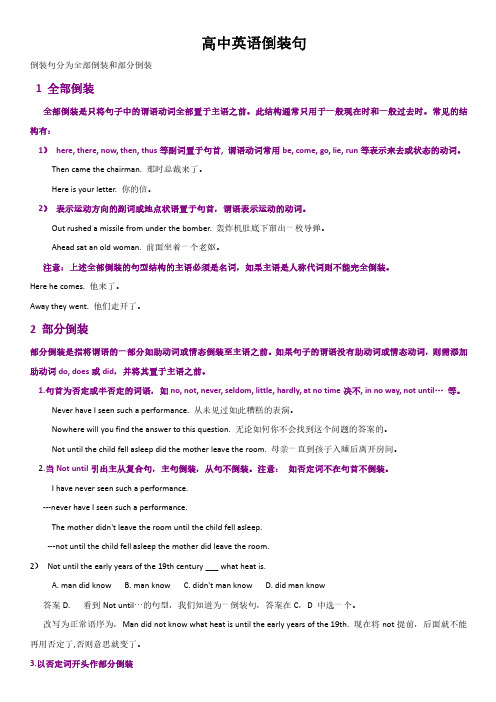
高中英语倒装句倒装句分为全部倒装和部分倒装1全部倒装全部倒装是只将句子中的谓语动词全部置于主语之前。
此结构通常只用于一般现在时和一般过去时。
常见的结构有:1)here,there,now,then,thus等副词置于句首,谓语动词常用be,come,go,lie,run等表示来去或状态的动词。
Then came the chairman.那时总裁来了。
Here is your letter.你的信。
2)表示运动方向的副词或地点状语置于句首,谓语表示运动的动词。
Out rushed a missile from under the bomber.轰炸机肚底下窜出一枚导弹。
Ahead sat an old woman.前面坐着一个老妪。
注意:上述全部倒装的句型结构的主语必须是名词,如果主语是人称代词则不能完全倒装。
Here he comes.他来了。
Away they went.他们走开了。
2部分倒装部分倒装是指将谓语的一部分如助动词或情态倒装至主语之前。
如果句子的谓语没有助动词或情态动词,则需添加助动词do,does或did,并将其置于主语之前。
1.句首为否定或半否定的词语,如no,not,never,seldom,little,hardly,at no time决不,in no way,not until…等。
Never have I seen such a performance.从未见过如此糟糕的表演。
Nowhere will you find the answer to this question.无论如何你不会找到这个问题的答案的。
Not until the child fell asleep did the mother leave the room.母亲一直到孩子入睡后离开房间。
2.当Not until引出主从复合句,主句倒装,从句不倒装。
注意:如否定词不在句首不倒装。
I have never seen such a performance.---never have I seen such a performance.The mother didn't leave the room until the child fell asleep.---not until the child fell asleep the mother did leave the room.2)Not until the early years of the19th century___what heat is.A.man did knowB.man knowC.didn't man knowD.did man know答案D.看到Not until…的句型,我们知道为一倒装句,答案在C,D中选一个。
全部倒装和部分倒装知识点

全部倒装和部分倒装知识点倒装是英语中的一种语法结构,常见于特殊句型或句子的词序变换。
倒装分为全部倒装和部分倒装两种形式。
全倒装是指谓语动词与主语互换位置,而部分倒装是指谓语动词中的助动词或其他辅助动词与主语互换位置。
一、全部倒装1. 在以表示方向、距离、时间等副词开头的句子中,常用全部倒装结构,即把谓语动词完全提到主语之前。
常见的副词有here, there, now, then等。
例如:There goes the bell. (这是句确句式,意思是“铃响了。
”)2.以否定副词开头的句子也常用全部倒装。
例如:Never have I seen such a beautiful sunset. (我从未见过如此美丽的日落。
)Rarely do we go to the cinema. (我们很少去电影院。
)3.在倒装句中,当句首为状语从句时,主句也要全部倒装。
例如:If only I had known the truth, I would have acted differently. (要是我早知道真相,我会有所不同的行动。
)When she arrived, so did he. (她到达时,他也到了。
)4.在以“介词+疑问词”开头的句子中,常用全部倒装。
例如:By what means was he able to escape? (他是用什么方法逃脱的?) With whom did you go to the party? (你和谁一起去的派对?)二、部分倒装1. 当句子以否定词或含有否定意义的词开头时,助动词或系动词要与主语调换位置,并在助动词或系动词后加not。
例如:They are not studying English. (他们不在学英语。
)2. 当so/such引导的结果状语从句位于句首时,要进行倒装。
例如:So tired was he that he fell asleep immediately. (他太累了,以至于立刻睡着了。
完全倒装与部分倒装

完全倒装与局部倒装1. 完全倒装1) 完全倒装即把整个谓语放到主语之前(是整个谓语动词,而非助动词)。
例如:In came the teacher and the class began. (老师走了进来,然后开始上课。
)2) there引出的完全倒装句:除了最常见的there be句型以外,there还能够接appear, exist, lie, remain, seem to be, stand等,一般都译成"有"的含义,构成完全倒装句。
例如:There appeared to be a man in black in the distance.(远处有个穿黑色衣服的人。
)3) 由地点和时间副词引出的完全倒装句:以地点副词here, there和时间副词now, then 开头,后面的动词是be, come, exist, fall, follow, go, lie, remain, seem, stand等,而主语又是名词时,构成完全倒装句。
例:Under that tree sits a beautiful girl.(那棵树下坐着一位美丽的姑娘。
)例:Down jumped the burglar from the tenth floor when the policeman pointed his pistol at him.注意:1) 在here, there引出的倒装句中,当主语是普通名词时用完全倒装句,但当主语是代词时,就要用局部倒装句。
例:Here comes the postman!(邮递员终于来了!注意实意谓语动词位于主语之前。
)Here we are.(我们到了。
注意系动词位于主语代词之后。
)2) 注意正语序和倒装语序的语气、意义是区别:例:Here is the picture I love.(这正是我所喜爱的画。
)The picture I love is here.(我所喜爱的画在这里。
完全倒装和部分倒装
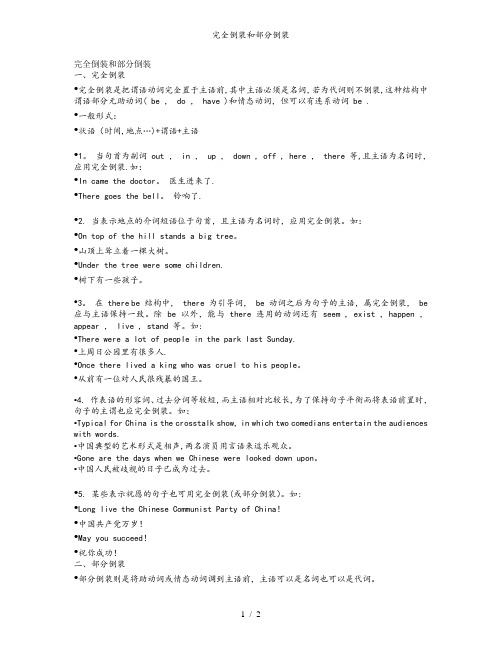
完全倒装和部分倒装一、完全倒装•完全倒装是把谓语动词完全置于主语前,其中主语必须是名词,若为代词则不倒装,这种结构中谓语部分无助动词( be , do , have )和情态动词,但可以有连系动词 be .•一般形式:•状语(时间,地点…)+谓语+主语•1。
当句首为副词 out , in , up , down , off , here , there 等,且主语为名词时,应用完全倒装.如:•In came the doctor。
医生进来了.•There goes the bell。
铃响了.•2. 当表示地点的介词短语位于句首,且主语为名词时,应用完全倒装。
如:•On top of the hill stands a big tree。
•山顶上耸立着一棵大树。
•Under the tree were some children.•树下有一些孩子。
•3。
在 there be 结构中, there 为引导词, be 动词之后为句子的主语,属完全倒装, be 应与主语保持一致。
除 be 以外,能与 there 连用的动词还有 seem , exist , happen ,appear , live , stand 等。
如:•There were a lot of people in the park last Sunday.•上周日公园里有很多人.•Once there lived a king who was cruel to his people。
•从前有一位对人民很残暴的国王。
•4. 作表语的形容词、过去分词等较短,而主语相对比较长,为了保持句子平衡而将表语前置时,句子的主谓也应完全倒装。
如:•Typical for China is the crosstalk show, in which two comedians entertain the audiences with words.•中国典型的艺术形式是相声,两名演员用言语来逗乐观众。
倒装(全部装和部分倒装)

倒装(全部倒装和部分倒装)在英语中,主语和谓语的语序通常是主语在前,谓语在后。
但有时谓语的全部或者一部分(通常是助动词或情态动词)却提到主语的前面,这种语序叫做“倒装”。
在倒装语序中,若整个谓语都在主语之前,称为全部倒装。
若只将助动词、情态动词或连系动词be等谓语的一部分放在主语之前,称为部分倒装。
Part 1:全部倒装(1)there be句型。
在此句型中,there是引导词,动词be后才是真正的主语。
其中be可换为appear, enter, come, exist, happen, lie, live, remain, seem, stand等动词。
There be +主语+其他正装:No schools or hospitals were there before.倒装:There were no schools or hospitals there before.正装:Some serious problems exist in the management of the company.倒装:There exist some serious problems in the management of the company.正装:An event happened last week.倒装:There happened an event last week.(2) 在表示方向、时间、地点的副词或某些表示地点的介词词组开头的句子里,如:副词here, there, now, then, in, out, away, up, off, down, back, over, in front of等,谓语动词是be,come, follow, go, begin等,且主语是名词时,句子全部倒装,以示强调。
公式:表示方向、时间、地点的副词/表示地点的介词词组+谓语+主语There goes the bell.Here comes the bus.正装:The bus comes here.The children rushed out the moment the bell rang.倒装:Out rushed the children the moment the bell rang.The chairman came then.倒装:Then came the chairman.A small garden was in front of the house.倒装:In front of the house was a small garden.A big steel factory lies south of the city.倒装:South of the city lies a big steel factory.注意:主语是代词时,主语和谓语不倒装。
英语全部倒装和部分倒装

倒装分全部倒装和局部倒装1、完全倒装〔Full Inversion〕:又称"全部倒装",是指将句子中的谓语全部置于主语之前。
此构造通常只用于一般现在时和一般过去时。
谓语+主语+……①There be〔的各种形式〕+主语〔+地点或时间状语〕例子:There are brids singing in the tree.鸟儿在树上唱歌。
②副词小品词+谓语动词+名词主语+……例子:Out rushed a young lady.③过去分词或现在分词+be的各种形式+主语+……例子:2.局部倒装〔Partial Inversion〕〔又称半倒装句〕:指将谓语的一局部如助动词或情态动词倒装至主语之前,而谓语动词无变化。
如果句中的谓语没有助动词或情态动词,那么需添加助动词do,does或did,并将其置于主语之前。
英语句子的倒装一是由于语法构造的需要而进展的倒装,二是由于修辞的需要而进展的倒装。
前一种情况,倒装是必须的,否那么就会出现语法错误;后一种情况,倒装是选择性的,倒装与否只会产生表达效果上的差异。
表示强调倒装句最突出、最常见的修辞效果就是强调,其表现形式如下:1.only +状语或状语从句置于句首,被该状语修饰的句子用局部倒装。
例子:Only in this way can you solve this problem.只有用这种方法,你才可以解决这个问题。
Only after he had spoken out the word did he realize he had made a big mistake.只有当他已经说出那个字后才意识到自己犯了个大错误。
2. hardly,in no way,little,scarcely,seldom,never,no more,no longer,not,not only,no sooner,not only … (but also),not until… 等具有否认意义的词或词组位于句首,句子用局部倒装。
- 1、下载文档前请自行甄别文档内容的完整性,平台不提供额外的编辑、内容补充、找答案等附加服务。
- 2、"仅部分预览"的文档,不可在线预览部分如存在完整性等问题,可反馈申请退款(可完整预览的文档不适用该条件!)。
- 3、如文档侵犯您的权益,请联系客服反馈,我们会尽快为您处理(人工客服工作时间:9:00-18:30)。
全部倒装和部分倒装英语最基本词序“主语部分+谓语部分”通常十分固定。
如果把谓语动词放在主语前面,这就叫做倒装。
将谓语动词完全移至主语之前,称为完全倒装;如果只是把助动词或情态动词放在主语之前,称为部分倒装。
一、全部倒装1.以here, there,now,then开头的句子,谓语动词要放在句子主语之前。
这种句子谓语动词常是不及物动Here comes the train! There goes the bell!注意:如果句子的主语是人称代词,则不能使用倒装结构。
Here it comes! There it goes!2.有些动词短语以副词out,in,up,down,away结尾,构成不及物动词短语。
为了使句子更形象,常将这些副词提前到句首。
句中的谓语动词要放在句子主语的前面,构成全部倒装。
(注意,句子主语是名词。
如果是人称代词,不能用倒装结构。
)Up went the rocket. Up it went.3.为了强调表示地点的介词短语,常将这个介词短语放在句首,构成全部倒装。
注意,这时句子的谓语动词通常是不及物动词。
In the front of the lecture hall sat the speaker.4.表语置于句首,且主语较长或结构较复杂的句子要用全部倒装。
Gone are the days when we had nothing to eat.5.so/neither/nor表示前面所说的情况也适合于后者,其倒装结构为“so /neither/nor+助动词/系动词/情态动词+主语”(so表示肯定意义,neither/nor表示否定意义)。
She has finished her homework,so has her brother. She hasn’t gone there,neither/nor has he.但如果so表强调,即强调前面所说的情况的真实性时,其结构是“so+主语+助动词/系动词/情态动词”,主语同前一个句子的主语指的是同一人或物。
She knows little English,so she does.一. 部分倒装1.用于疑问句中。
How did you do that﹖ Did you see the filmyesterday﹖2.用于省略if的虚拟条件状语从句中。
如果我们将连词if省略,应把were,had,should提到主语前面。
If you had come yesterday, you would have seen him.Had you come yesterday,you would have seen him.3.用于as引导的让步状语从句中。
as引导的让步状语从句引起的倒装有以下几种形式:1) 副词置于句首。
Much as I like it (=Although I like it very much), I will not buy it.2) 动词原形置于句首。
Wait as you may(=Although you may wait), he will not see you.3) 形容词或名词置于句首。
Proud as the nobles are (=Although the nobles are proud), they are afraid to see me.Child as he is (=Although he is a child), he can tell right from wrong.如果名词前有形容词修饰时,as 引导的倒装句中要保留不定冠词。
A bad-tempered man as he is (=Although he is a bad-tempered man), he loves me deeply.4.具有否定意义的副词或连词(not,hardly,no sooner, not until, seldom,not once,at no time,never,little等) 置于句首时,句子(主句)采用部分倒装。
Little do we know about him. No sooner had he closed his eyes than he fell asleep.Seldom does he come back on Sundays. Not until he came back did I know about it.5.only修饰句子的状语(从句)位于句首时,句子(主句)要用部分倒装。
Only then did I realize the importance of English.如果only修饰的是句子的其它成分,则无需倒装。
Only socialism can save China.(only修饰的是句子的主语,故仍用正常语序。
)6.not only…but also… 连接两个并列分句时,第一个分句应使用部分倒装。
Not only does he do well in his lessons, but also he often helps others with their lessons.7.so…that结构中的倒装。
有时要强调so所修饰的形容词或副词,常将so 连同它所修饰的形容词或副词一起提到句首。
这时,主句要用倒装结构。
He runs so fast that he is far ahead of others.→So fast does he run that he is far ahead of others.He is so clever that he can work out all the difficult problems in the book. →So clever is he that he can work out all the difficult problems in the book.(全部倒装)倒装的原因有二:1)由于一定语法结构的需要,Have you known Mr. Davis long?你认识戴维斯先生很久了吗?Where have you been?你刚才到哪里去了?Was the car damaged by a truck?这辆小轿车是让大卡车给撞坏的吗?2)由于强调Only then did I fully understand what my father said.只有到那时,我才充分理解我父亲讲的话。
倒装结构的基本用法在下列情况下,通常用倒装句。
.1)在问句中,What does your father do?你父亲干什幺工作? How are you?你身体好吗?Is he singing of is his brother?是他在唱,还是他弟弟在唱? Was your school setup in 1958?1) 在“there + be”结构里, There are many tall buildings in Hong Kong.香港有很多高建筑物。
There is a plane at the airport.飞机场上有一架飞机。
3)在以here(这里),there(那里)等副词开头的某些句子里(须用现在一般时),There goes our director.我们的主任走了。
There goes then bell.铃响了。
Here is a ticket for you.这儿有张票给你。
Here comes the bus.公共汽车来了。
如果主语是人称代词,主语和谓语动词的词序则不变。
There he comes.他来了。
Here it is.在这儿(或这就是)。
4)虚拟结构中的条件从句省去it时这时were,had和should须移至主语之前。
He would do more work were he in your place.如果他是你的话,他会干更多工作。
Should I earn more money,I should live better.如果我能赚更多的钱,我会生活得好些。
You would have done well had you taken her advice.你如果听她的意见,你就会干得好些。
5)直接宾语如果是直接引语的全部或一部分往往放在句首,这时主语和谓语动词也可颠倒位置。
“You all made great progress last term,”said the teacher.老师说:“你们上学期都取得了很大的进步。
”“Miss smith,”replied the monitor,“our success is inseparable from your hard work.”6)在某些表达祝愿的句子里Long live the people!人民万岁! May you all be happy!祝你们大家愉快!7)在表示“我也这样”一类概念的结构里,其公式是:肯定:so + be,have,助动词或情态动词+主语否定:neither (nor) + be,have,助动词或情态动词+主语He has visited the museum. - so have I.他参观了博物馆。
——我也参观了。
They can play chess. -so can we.他们会下棋。
——我们也会。
He is a basketball fan. -so do I.他是一个篮球迷。
——我也是。
He isn’t a businessman. -neither am I.他不是商人——我也不是。
They were not thirsty. -nor were we.他们不渴——我们也不渴。
The boy can’t swim across the river. -nor can his brother.这男孩游不到河的对岸——他弟弟也不行。
8)在某些副词开头的句子中,在用never(从来不),hardly(几乎不),only(只有),no sooner...than(刚一…就),nor(也不),scarcely...when(…就…),little(很少)等副词开头的句子中。
No sooner had I gone out than he came to see me.我刚出去,他就来看我来了。
So loudly did he speak that everyone could hear him clearly,他讲话声音很大,每个人都听得清楚。
Under no circumstances will we be the first to use nuclear weapons.我们在任何情况下决不首先使用核武器。
